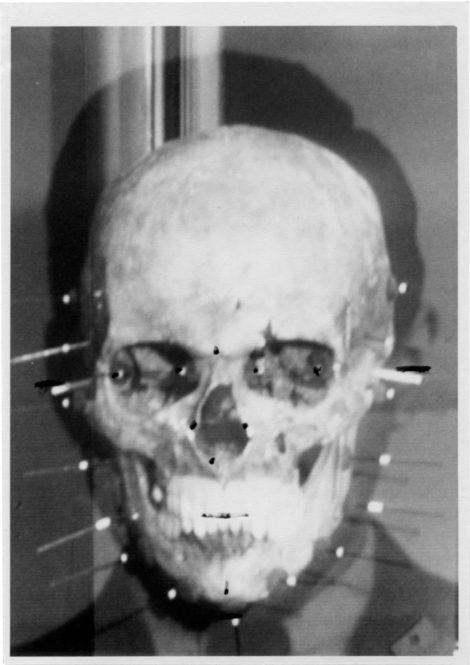
Richard Helmer (forensic photography. Mengele’s Skull exhibition)
“Kafka’s idiosyncrasy is present in each of these writings [by Zeno,Han Yu, Robert Browning, and Søren Kierkegaard], to a greater or a lesser degree, but if Kafka had not written, we would not perceive it; that is to say, it would not exist. The fact is that each writer creates his precursors. His work modifies our conception of the past, as it will modify the future.”
Jorge Luis Borges (Kafka and His Precursors)
“The discontent in our culture has assumed a new quality: It appears as a universal, diffuse cynicism. “
Peter Sloterdijk (Critique of Cynical Reason)
“I decide who is a Jew.”
Karl Lueger (Mayor of Vienna, 1897)
“Fiction is history, human history, or it is nothing. But it is also more than that; it starts on firmer ground, being based on the reality of forms.”
Joseph Conrad (Notes on Life and Letters)
I can’t seem to shake this feeling of a new emergence of the grotesque all around me. I feel public figures are uncommonly ugly in a way that wasn’t true a mere forty years ago. One fantasy silent storyline I tell myself is that this is like another version of John Carpenter’s They Live, and somehow the secret of the inner toxicity of the ruling class can no longer be disguised (we all have those sunglasses). I should clarify that I am thinking of the EU and North America (and Israel and perhaps one or two other places. For the leaders of the coups in Niger and Burkina Faso are quite vigorous and handsome). I thought of this watching the German foreign minister, Annalena Baerbock. But I have felt this, of course, with Biden , with any of his cabinet and advisors; the Sullivan brothers, Jake and especially Tom. I experience it with, seemingly, all the EU health ministers (starting with Belgium and the UK). I feel it with the unelected NGO or hedge fund billionaires like Gates and Larry Fink. I felt it with Jacinda Ardern, or Niki Haley, or BoJo, Trump, or Karl Lauterbach, or Al Gore. And with any of the British royal family. Someone once said tragedy was replaced by the grotesque. Maybe that’s true. But this new promotion of ugliness (and more on that word below) leaks into marketing (the trans-men beauty contest winners for example). And I see it in all the plus size models (sic). If I thought these strategies actually led to less ‘fat shaming’, I’d be heartily supportive. But I think it does the opposite, often. And maybe it is the lurking dishonesty in such campaigns. The plus size model is presented as if she is haute couture skinny. The framing is typical of the size four culture of *fashion*. Normal (plus) sized women are of another culture. Another frame. Besides the fact that all of such advertising is objectifying women, as it objectifies everyone including the viewer. The fashion industry uses very young models — itself a questionable practice both ethically and aesthetically. In essence these strategies actually double stigmatize.
But I am writing about the *inner* ugliness of decision makers now coming to the surface and about something dishonest in all such ‘woke’ ideas. I remember when Kate Moss was roundly criticized for saying “Nothing tastes as good as skinny feels”. I thought it was a great jingle to those wanting to lose weight. (and by the way, skinny is healthier). Ok, but I am digressing. This idea of the grotesque and of ugliness, has deep links within our psyche.
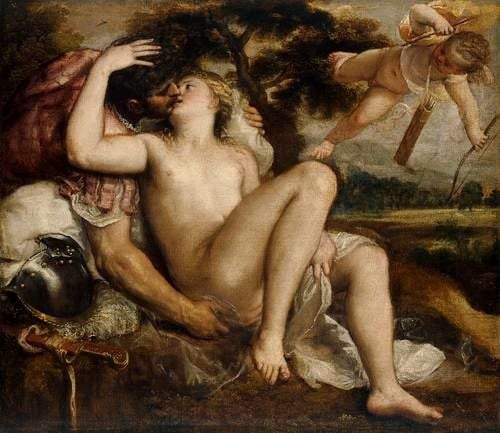
Titian (Mars, Venus and Cupid, 1530)
And there is a tendency today that is hard to resist. And that is to start seeing the obvious deterioration in western society, and in global infrastructures, in terms apocalyptic Joachites would applaud. The Biblical prophecies so embraced by Blake and D.H. Lawrence. But it is worth considering the deeper psychoanalytic underpinnings of the Four Horsemen or dragons or harlots. (Mormons seem to love the book of revelation, just sayin’). But putting that aside for a moment, there is a feeling many have (I have it) of very irrational and emotionally disfigured people in charge of decision making. The ruling class decision makers have always been morally compromised, and even endowed with offensive personalities, but today they appear as if a part of a global transition to absolute grotesquery.
And questions of ugliness immediately conjure questions of beauty, and of health or unhealth. There are two basic arteries of ugliness that seem to be appearing. One is that somehow media, and by extension the official electronic media industry, has seen the necessity to veer away from Hollywood and Vogue magazine ideas of sex appeal. And this is simply a sophisticated marketing ploy to virtue signal AND capture new attention. But I suspect the ugly-phenomenon is more about the kinds of people willing (and able) to run for office and endure all that implies. Only the damaged will apply. What else would a Niki Haley do, after all? But its also, more, economic. Very wealthy people run for office. So right off the bat, politicians are going to be the product of ruling class inbreeding. (I don’t know if I’m joking here or not).
The public arena is reserved for the most unappealing humans alive. I remember writing about this in a slightly different context here https://john-steppling.com/2014/04/privatized-suffering/
The ugliness is tied to something, the same something, that drove mid century fascism. And as has been exhaustively noted, Nazism never died, it went into hiding and dispersed globally. It is also difficult to pick a starting place, but fin de siecle Vienna is a popular choice.
“People both in and out of academia return obsessively to the history of Vienna, which has been home to an almost implausible number of artists, innovators, heroes, and villains – Wolfgang Amadeus Mozart, Ludwig van Beethoven, Franz Schubert, Gustav Mahler, and Arnold Schönberg in music, Ernst Mach, Martin Buber, Ludwig Wittgenstein, Karl Popper, and the Vienna Circle in philosophy, Carl von Rokitansky, Theodor Meynert, Josef Breuer, Sigmund Freud, and Ignaz Semmelweis in medicine, Otto Wagner and Adolf Loos in architecture, Theodor Herzl and Adolf Hitler in politics, not to mention the macabre Prince Rudolf, executor of the gruesome murder-suicide known as ‘The Mayerling Incident’, and the doomed Archduke Franz Ferdinand – whose assassination set off the First World War. Toname only a few of many more, Vienna was also home to writers Stefan Zweig, Hugo von Hofmannsthal, Arthur Schnitzler, and Karl Kraus, and to visual artists Gustav Klimt, Richard Gerstl, Oskar Kokoschka, and Egon Schiele, as well as the Vienna School and Ernst Gombrich in art history.”
Kathryn Simpson (Making Monsters; Ugliness, Hatred, and Self-Representation in Viennese Modernity)
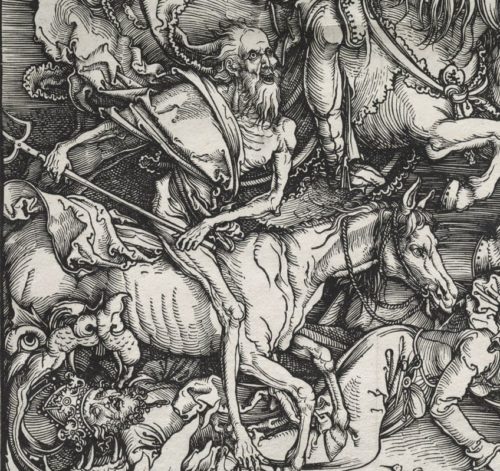
Albrecht Dürer (Four Horsemen, The Apocalypse, detail 1496)
Kathryn Simpson’s thesis paper on ugliness and self presentation in fin-de-siecle Vienna is rather remarkable. Besides the excellent research, Simpson’s central idea is extraordinarily useful for illuminating and explicating the contemporary version of this phenomenon.
“The strategic decision to present oneself as loathed, diseased, and ugly began to dominate
Viennese visual arts in the early twentieth century. But these strategies of ugliness were related to contemporaneous Viennese culture and its various discourses of hate. Hatred and ugliness were inextricably intertwined in early-twentieth-century Viennese theory and practice, with various commentators – including artists, journalists, scientists, and art historians – pointing to the ways in which ugliness produces feelings of hate and hate affects visual perception.”
Kathryn Simpson (Ibid)
Simpson goes on to say the subjects of Freud’s Vienna (or Wittgenstein’s, or Mahler’s etc) “somatized a sense of traumatic psychic identity. Psychological conflicts were recast in physical terms.”
Artists and writers reacted hysterically. And while hysteria is usually associated with the feminine, the reality is quite the contrary. The somatization of psychic distress found aesthetic expression in artists, writers, and musicians. And in philosophy. And the work produced, and the culture that evolved, are worth investigation. The ambivalence and crisis of identity in bourgeois Hapsburg culture gave expression to an unconscious ugliness and cynicism. And it is pertinent to note the presence of Wittgenstein here. Historians of Vienna during this era tend to see the aesthete philosopher as an outlier. Not a part of the dynamism of daily cultural activity, or of daily political activity. But Vienna’s position as a cultural magnet carried additional resonances and meanings.
“Marjorie Perloff, in Edge of Irony, identifies a distinct strain of modernism that she calls Austro-Modernism, composed of writers raised in the former Habsburg Empire, though not born in Vienna. Instead, they came to the city, the center of Habsburg gravity and synecdoche of the cosmopolitan world, as young adults from the provinces. She profiles Kraus, Roth, Musil, Canetti, Paul Celan, and Wittgenstein as Austro-Modernists, identifying a common sensibility: ‘its conviction, most memorably expressed by Wittgenstein, that argumentation called for not linear discourse but a series of aphorisms, its transvaluation of normative values, its fondness for paradox and contradiction as modes of understanding, and especially the hard edge of its savage and grotesquely comic irony’.”
Matt Levin (Thomas Bernhard, Karl Kraus, and Other Vienna-Hating Viennese, Paris Review 2018)
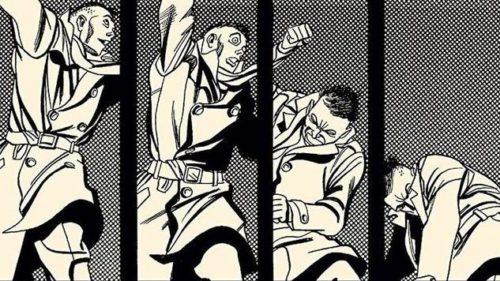
Bernie Krigstein (illustration for The Master Race)
“Running beneath the oversized self-congratulatory optimism of the late nineteenth century, however, were darker currents. The finde-siècle concept connotes decadence, decline, degeneration, and death. Dire self-diagnoses of the age—of which Max Nordau’s Degeneration (1893) and Gustave Le Bon’s Crowd Psychology (1895) were only the best-selling examples—likened the time to the late Roman Empire and the biblical fall. For many contemporaries, particularly cultural traditionalists and social conservatives, signs of the age’s dreadful downward tendencies were everywhere. Religious faith, which had provided moral discipline and underpinned European civilization, was rapidly waning in the current era of materialism and scientism.”
Mark S. Micale (Hysterical Men)
Interestingly, starting in the 1880s, urban crime rose precipitously, as did the so called ‘social pathologies’ of suicide, addiction, and mental illness. The front edges of movements for feminist emancipation began, to the horror of conservatives (most European universities began accepting women students, though not Cambridge or Oxford). Homosexuality (a term recently coined) became more open in large urban centers, again causing alarm among the status quo.
“At the same time, a steady stream of arrests for acts of “gross public indecency” by “pederasts” and “inverts” reinforced the middle-class equation of crime and male homosexuality. The tabloid presses across late Victorian Europe published sensational accounts of homosexual activities, including the Germany affair of 1876–1877,involving a lawyer from a distinguished family arrested in a public urinal along the Champs-Élysées; the Cleveland Street Scandal of 1889–1890, which brought to public attention the world of high-class rent boys in West End London; Oscar Wilde’s prosecution in 1895; and the Eulenberg affair of 1907–1908, concerning the purported homosexuality of the German chancellor and members of the Kaiser’s circle. Against this background, the Boy Scouts, leagues for “social purity,” and campaigns to reform boys’ public schools were launched as strategies for maintaining healthy, heterosexual masculinity.”
Mark S. Micale (Ibid)
Micale notes that luminaries like Teddy Roosevelt and Rudyard Kipling decried the effeminization of men, and the dangers of such weakening (sic). Now, the bourgeoisie across Europe were increasingly hysterical about these perceived social ills. Right up the break out of WW1. Now, I don’t want to get too far afield here, if that’s what I’m doing, but the Imperial courts of Europe, most particularly in England and Germany (and in the U.S. in another register) emphasized a militaristic education for young men. Only France lacked such a super-structure (Cheese-eating surrender monkeys).

Egon Schiele (1918)
“The Third Republic, France’s first sustained and successful experiment in democracy, owed its existence to the country’s swift, catastrophic defeat by the Prussians, who in turn used the French humiliation on the battlefield to achieve their long-sought national unification. Throughout the 1870–1914 period, the German annexation of the formerly French territories of Alsace and Lorraine was often characterized as a dismemberment or castration of the French nation. Not surprisingly, the French imperial drive during the 1880s and 1890s in North Africa, Madagascar, and Indochina was widely regarded as compensation for France’s military and territorial losses at home.”
Mark S. Micale (Ibid)
The hysterical man was a feminine man. And in fin-de-siecle Vienna, the somatizing of psychic trauma was aestheticized as well. Simpson quotes Juliet Mitchell…:“for the hysteric, hatred ‘is an emotional response to the need to survive in hostile conditions’.”
There was in the fin-de-siecle period an acute ambivalence about the societies of Europe, by its inhabitants. Simpson quotes John Carey’s introduction to Freud’s Jokes and their Relation to the Unconscious:
“Jewish immigration from Eastern Europe was increasingly resented in the Vienna of
Freud’s youth. Between 1857 and 1880 the proportion of Jews in the city’s population
rose from 2 to 10 percent. The stock-market crash of 9 May 1873 (‘Black Friday’) led to an
orgy of anti-Semitism. Jewish bankers were blamed for the catastrophe. A rash of anti Jewish propaganda hit the popular press, with cartoons depicting hook-nosed financiers.
This was the year Freud went up to university.”
The self hatred of Viennese men at this time bares a striking resemblance to the self hatred of the contemporary Westerner. As does the outward projected bigotry and prejudice. And every narrative trope for resentment and racial stigmatizing are in place, only Jews are now Arabs or Muslims. In Vienna at the end of the century up until the outbreak of WW1, there was a gradual but inexorable intensification of anxiety and internal conflict — subjective individual ambivalence about identity and society both. The rabid (hysterical) anti semite Karl Lueger was elected mayor Vienna in 1895. And Hitler later studied at his feet. Lueger was in his way the Trump of Vienniese society. This was the city of both psychoanalysis and Zionism. In an era, overall, in Europe, that saw remarkable optical inventions, and a sudden opening of science to fields of study previously deemed unacceptable in polite society. From Darwin to Galton, to Kraft-Ebbing and even the bizarre story of Otto Weinniger, this era was the laboratory for modernism. It created modernism. It largely laid the ground work for the 20th century, and that includes Hiroshima and Auschwitz. That much of the technological innovation was in the service of propping up white supremacism and class hierarchy, is pretty exhaustively covered (see Jonathan Beller, The Message is Murder for one).
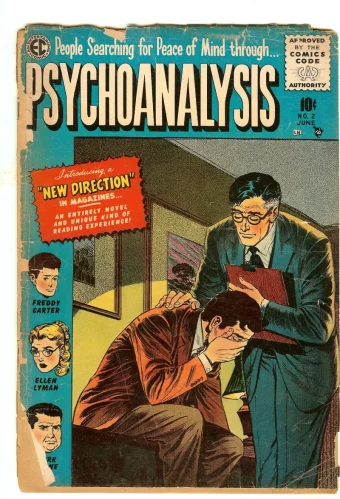
Jack Kamen, illustrator (1955)
Kathryn Simpson (Ibid)
The acute antisemitism of Vienna was mirrored in less virulent ways in London, Paris, Zurich, and Berlin. And there was the growing anxiety of masculine potency. That age’s girlie men crisis, which accounted for many of the European bourgeoisie applauding the outbreak of the war. Also worth mentioning is that while numerous studies and investigations on male hysteria were conducted in France, and Germany, there were literally none in England. (well, apparently one but it was anonymous). The stringent British ruling class panic about masculinity and public school homosexuality completely crippled the society. And the antisemitism was probably just as lacerating as the Austrian but was also kept hidden, largely.
Freud said laughter was a way to not get angry. And that this was necessary in a society that was “…more and more robbing us … of the capacity for feeling angry.” (Ibid) The idea was that laughter allowed for an escape from deeper emotions, ones that might have ambivalent aspects. The evolution of humour is a complex topic, but I would argue (and have before) that laughter is more neurotic than it was 130 years ago. And that laughter’s increasing shallowness allows it a larger role in the releasing of tensions connected to ambivalence. The lack of genuine humour may mirror the lack of tragic emotions. In that sense the Comedy Club or Improv are not release mechanisms, but manufacturing centers for the self loathing of the new ugliness, and the latent fascist.
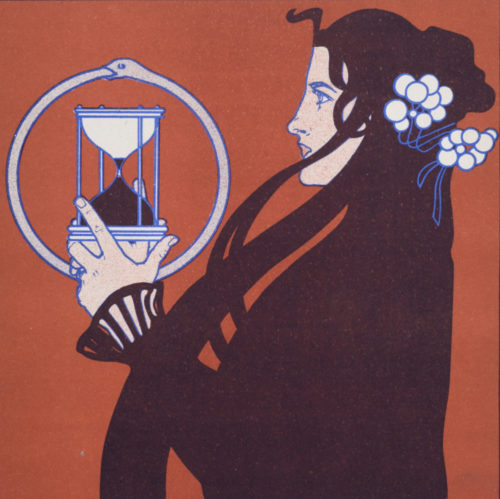
Koloman Moser (1903)
“Caricature made visible – and accessible to the Viennese public – antisemitic discourse that was medically inflected, however unscientifically. The theory that Jews were “especially prone to hysteria and neurasthenia because of a weakening of the nervous system due to inbreeding appeared in canonical form in French neurologist and pathologist Jean-Martin Charcot’s Tuesday Lesson for 23 October 1888” and was perpetuated by the psychiatric community thereafter. The comparatively liberal Austro-German psychiatrist Richard Krafft-Ebing discussed hysteria and connected it to Jewishness in his Text-Book of Insanity (1905).”
Kathryn Simpson (Ibid)
Today, the medicalization of prejudice takes the form of atavistic mythologies of racialist categories. Israeli (ironically) leaders refer to Palestinians as animals, as savages, as little snakes. The Muslim is the new Jew. If, as I wrote of earlier, the Jew was the biological other, the Arab was the political other. Today the Arab/Muslim is both. And Jewish imagery has diluted and self cancelled, in a sense. Zionism, however, is now finding itself the target of hatred; Zionists as prison guards. The Attica Uprising keeps coming to mind. https://www.zinnedproject.org/materials/attica-prison-uprising/
Zionism is one branch of the colonialist project that drove white supremacist thinking from the Industrial Revolution onward. Gottfried Benn said somewhere (and I paraphrase) ‘To be dumb and have a job, that is happiness’. And one clear overriding quality of life today is a sense of social decay. Everything is described as decaying, and such descriptions are largely right. But, there is a metaphor here that gets ignored. People psychologically *feel* this decaying process. And again, here one comes up against language. The fin-de-siecle Vienna was, in many respects, the birthplace of modernism. Or if not the birthplace, at least the kindergarten for modernism. And one problem with the lack of metaphorical recognition is how people, largely, have lost the ability to listen. I wonder if generally there has been a loss of hearing accompanying the emergence of the Ugly. The erosion of literacy, the inability to read complex sentences, to think critically, must certainly have physiological accompaniments. But ideas such as *society is decaying* are facile and sort of cocktail party chit chat level deep. More revealing is the metaphors chosen. Like Freud with jokes and humour, one could profitably list the metaphor and its relation to the unconscious.
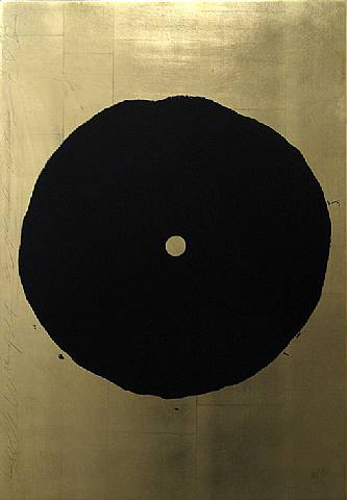
Donald Sultan
“The final reason for resistance to male hysteria, a psychological reason, is the most complex. The medical history of female hysteria is an account of how men in power have seen women—the story of a controlling, panoptic gaze of one sex onto the other. But the medical history of male neurosis differs: it is not a construction of the collective “others” of modern and early modern Europe
(women, colonials, Jews, homosexuals, criminals); it is, rather, a discourse of the self. This distinction is all-important. To follow through on such a project requires an act of sustained, analytical self-reflexivity—a “turning of the male gaze inward”—and that endeavor is not only politically dangerous but psychologically fraught. To be self-aware is itself *unmasculine*. “
Mark S. Micale (Ibid)
“This notion of a Germanic tradition of confession is another way to link figures discussed here, particularly the self-portraitists. In Vienna the compulsion to confess – an urge stained by its association with sin – formed the foundation of what have turned out to be enduring aesthetic, psychological, and philosophical investigations. Early-twentieth-century Viennese self-representational practices, particularly those that relied on strategies of ugliness and discourses of hate, seemed to have had a cathartic function for those who were or felt persecuted, for those struggling with a traumatic sense of identity, and for those lingering – as Freud framed it in his discussion of the local suicide epidemic – at unpleasant stages of development.”
Kathryn Simpson (Ibid)
This is all serves as a sort of preface to my idea of contemporary grotesquery. That the catharsis of fin-de-siecle Vienna (and after, throughout post WW1 Europe, especially Germany) was linked to hate and somatized physical discomfort. The extent to which this particular culture produced this particular aesthetic expression remains unclear. The most telling aspect is of course Nazism and its cult of purity and Aryan racial supremacy.
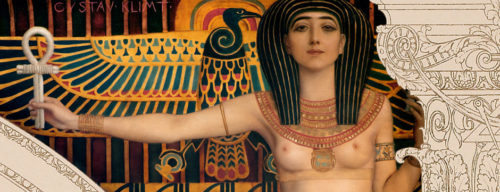
Gustav Klimt
Today popular culture, certainly in Hollywood film, produces a surplus of horror films. The monster has replaced the self portrait of the Ugly. The film monster is, of course, a dispersed confessional of personal ugliness. The relation between monsters and ugliness is not exactly simple either. But the never ending appetite for horror films, for supernatural or monster narratives (and this began mid century with comic books) suggests the migration of the fin-de-siecle portrait of Ugliness to the portrait of society’s monsters. But the monsters seem not to come from within (they did once upon a time in film, during German expressionism and early US silent films). The monsters are projections, the confrontation with personal guilt and shame is now the stigmatizing narrative of societal dangers (the Other, science gone awry, or communism).
Writing of Westerns, Franco Moretti observes:
“Why does the Western have such a hold on our imagination?” asked Robert Warshow in his “Movie Chronicle”; chiefly, he answered, it’s because “it offers a serious orientation to the problem of violence such as can be found almost nowhere else in our culture. One of the well-known peculiarities of modern civilized opinion is its refusal to acknowledge the value of violence. This refusal is a virtue, but like many virtues it involves a certain willful blindness and it encourages hypocrisy.” “My hunch is there won’t be any trouble,” declares a character in High Noon: “Not one bit.” No trouble—when four gunmen are in town to kill the marshal? This is the blindness Warshow had in mind. Time and again, the Western contrasts it with the reality of violence: someone steals cattle, or robs farmers and miners of their land; then threatens them; then kills. And so, sooner or later, violence has to be accepted, not just as an aspect of social life, but as its very foundation. ”
Franco Moretti (Far Country)
We see today a discussion of violence in the Israel assault on Gaza (which has been going on for 75 years). Americans accept state violence. They do not feel comfortable, at all, with revolutionary violence. The arts in turn of the century Vienna carried a personal sense of ambivalence. Male hysteria was both generated by sexual anxiety, a fear of castration, but also by the unrelenting antisemitism of Viennese culture. In the US a hundred years later the antisemitism had been subsumed (if only temporarily) by anti black racism (and the fear of *Indians* and commies both. In fact the native American came to emotionally feel like a communist). But film had replaced the other arts and by the 1950s, both film noir and the Western were dominant genre rituals of regeneration (per Richard Slotkin’s excellent trilogy on the West).
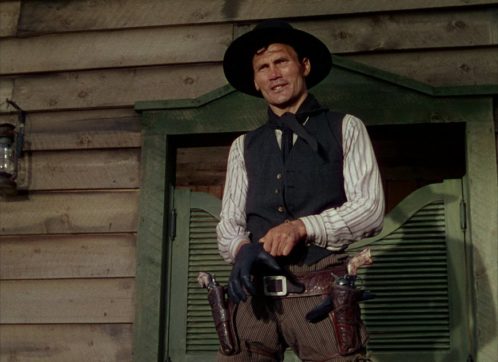
Jack Palance (Shane, 1953)
“Conflict becomes geometry: friend and foe, one in front of the other, with nothing in between, advancing in a straight line while looking into each other’s eyes. Distance is stylized, too: not too far, and not too close; two men moving slowly towards each other—John Wayne’s and Henry Fonda’s main acting feature: the way they walk—as if to measure the exact spot where shooting can start. It’s a dance. In film noir, one is shot from a few inches away, or with the gun’s barrel touching the body, like Stanwyck in The Strange Love of Martha Ivers (1946), or Mitchum in Out of the Past (1947): an index of these films’ deadly mix of intimacy and treachery. In the Western, shooters are twenty or thirty steps apart; a public dimension, in the town’s main street, at midday.”
Franco Moretti (Ibid)
The two features of masculine acting, post WW2, were the voice and the walk. Radio had produced in the American audience a certain sensitivity for voice (James Mason, Ronald Coleman, Cagny, Herbert Marshall, Bogart, Basil Rathbone, Jack Palance, Burt Lancaster, et al) and the *walk*. Wayne of course had a preternatural grace that John Ford recognized immediately. But Fonda, Lancaster, and later Lee Marvin and Mitchum, all were big men (Sterling Hayden, too) who had uncommon grace in their movements. Moretti remains the best cultural critic alive, and it is worth including his juxtaposition of Westerns and Film Noir. One is binary (the western) and one is a triad (noir). The noir is urban, and it it intimate, and it remains predicated on societal ambiguity. The western is never uncanny. The western is Homer, Noir is the King James Bible. Noir is also about crime. In the western the law (the state) is theoretical. It is moral, but it might be absent. In noir the state is treated with suspicion. Everything is treated with suspicion, and this ambivalence leads to madness. Morality is the personal code of the lone detective (or in a later incarnation, the outsider cop).
“Here, too, titles are a good index of the genre’s perspective on the world: vaguely threatening metaphors (Whirlpool, Nightfall, Vertigo, Impact, Blast of Silence—and, to be sure, Double Indemnity); an enigmatic use of the definite article (The Naked Kiss, The Third Man, The Dark Corner, The Clay Pigeon … which corner? what pigeon?); and plenty of allusions to unintelligible events: The Postman Always Rings Twice, Ride the Pink Horse, Where the Sidewalk Ends, They Live by Night.”
Franco Moretti (Ibid)
The unintelligible event. The uncanny. But society, meaning the Imperialist US, was becoming a rabid engine of anti-communist hysteria. Male hysteria was being incorporated in both an intoxication with futurism (scientism) and with authoritarian institutional edicts. It is interesting to note that Hollywood can no longer make Westerns of any depth, nor make film noir (crime) of any value, either. For both these genres contain acute moral positioning. Politicians often want to be seen as Cowboy heroes (Reagan, Bush, among others), as the frontier marshal — but you never see a politicians looking to be seen as a PI, as Sam Spade or Philip Marlow. Politics cannot abide such ambivalence.

Carl de Keyzer, photography (Holy Land theme park . Orlando Florida 2019)
“From the early seventeenth to the early twentieth centuries, European medical science failed to achieve a cumulative, formalized, disciplinary discourse of emotional and nervous illness in males akin to what it created for women or for other pathologies in both sexes. This, I believe, is the true male malady—not the pains, twitches, and obsessions that accompany the human condition, but the chronic inability to reflect nonheroically, without evasion and self-deception, on oneself individually and collectively.The “failed enterprise” that is the subject of this book did not, of course, end with the publication of Freud’s Three
Essays on the Theory of Sexuality in 1905. There is an eventful twentieth-century sequel to this story, which features the battle trenches of Verdun and the Somme, the psychoanalytic diaspora, film noir of the 1950s, the successive editions of the Diagnostic and Statistical Manual of Mental Disorders, the advent of feminist psychologies, and the post traumatic stress disorders (PTSD) experienced by Vietnam and Iraq veterans, among many other events.”
Mark S. Micale (Ibid)
But more than a moral deficiency, the arts (and here, again cinema is the premier medium, though perhaps this is about to change) have deteriorated.
Micale concludes his lengthy essay :
“As in psychoanalysis, their theories of human mental functioning were markedly less gendered than the psychologies they replaced and often addressed issues of masculinity and femininity. In a parallel development, Western psychiatry, beginning in the last third of the twentieth century, has increasingly withdrawn from the hysteria diagnosis itself, judging it to be a historical artifact that is as sexist, overgeneralized, and unscientific clinically as it is colorful historically. Today’s successor categories to the great neurosis are free of ancient gender associations. No one claims that “somatization disorder,” PTSD, “idiopathic pseudo-seizures,” and “psychogenic pain disorder” are male or female maladies. { } whole new disciplines of inquiry and bodies of theory, such as gender studies, the history of the body, and queer theory, have arisen that take “the history of masculinities” as a field of critical, comparative scrutiny. The synthesis of these developments—modern wars, trauma theory, psychodynamic psychiatry, human rights movements, academic gender studies—signals a fundamentally altered cultural environment for viewing and discussing gender in general, and masculinity in particular. ”
Mark S. Micale (Ibid)
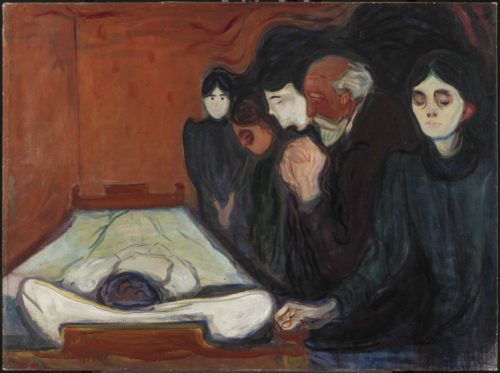
Edvard Munch (At the Death Bed, 1895)
And the problem is, these new fields are regressive and reductive, they are dishonest in demanding a historical revisionism that pretends certain crimes did not take place. Hollywood cannot make an honest crime story because there is a deep collective denial about the psyches of the West today, crimes are the product of *criminals*, and maybe, occasionally social conditions that have fallen from the sky. We are never the criminal. The erasure of psychoanalysis has meant the validation of superficiality, emotional shallowness, and then most dramatically, a numbness rather than guilt. Of course this is a very depressed society, too, and that suggests guilt and shame still exist but have simply been driven deeper underground.
“Freud wrote Mourning and Melancholia (1915) under the in¯uence of the events of the First World War, which forced him to think of man’s recurrent destructive capacity. Here he set out his first theory about sense of guilt. The context was depression (for which ‘melancholy’ was virtually a synonym). Freud noted that melancholy was characterised psychically by a deep and painful dejection, a reduced interest in the outside world, a loss of the capacity to love, an unwillingness to engage in almost any activity and “by a feeling of despondency about self which expressed itself in self-reproach and self-berating, culminating in the delusional expectation of punishment”: delusional because it can go as far as suicide. The self-reproaches that the melancholic directs against himself `’are really reproaches directed against a love object which are then diverted away from the object itself and aimed at the patient’s Ego’.”
Roberto Speziale-Bagliacca (Guilt)
Maybe the current emergence of the grotesque is partly that artistic expression is stagnating, even in popular arts. And the loss of reading has left a public unable to process complexity in narrative, or depth emotionally. Certainly there are still many who can and do, but I think the grotesque is a trend that is linked to this denial of history, both personal and collective. This physical grotesquery is an allegory of western society — the history of capitalistic western society has been one in which mediocrity is naturally rewarded, and original dissent and creativity is punished bureaucratically. There has evolved a structural encouragement to reward the least imaginative, and simultaneously to restrict vitality and health, to restrict the naturally attractive. The puritanism that has always lurked in American society is a shadow that darkens those fecund and fertile. Career promotions are more easily granted the most emotionally unhealthy. This is not terribly far from Reich, I realize.
But I want to close with, again, trying to correct what I feel are profound mistakes about the origin of art and culture.
Here is a brief paragraph in an essay by Sven Lütticken…
“In 1842, Marx studied Charles de Brosses’s classical treatise on African fetishism, a notion he also encountered in Hegel. Fetishism denoted a state of religion and of culture before the emergence of art properly speaking; a stage lower than idolatry, before humans formed matter, when they worshiped—according to De Brosses—random objects. For Hegel, consequently,fetishism had no place in the history of art, and a place in the prehistory of religion at best.”
Sven Lütticken (Filming Capital)
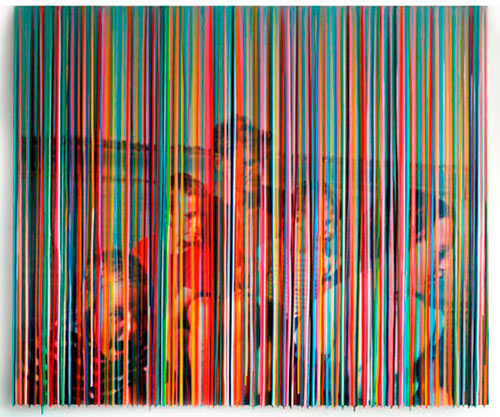
Markus Linnenbrink
This idea of de Brosses is pretty problematic. Because, as I continue to maintain, art (and certainly theatre, which is the ur-medium) constituted a stage before religion. But probably, this also depended on specific groups and specific places. I wonder what is meant by the word ‘matter’ in this paragraph. Never mind, the point is that human language arrived at the same time as art, and religion both. But conceptually it makes sense that the psychic trauma of humanness is the force that creates a space, a stage, which precedes all else. A stage exactly necessary for enacting that trauma. Somehow. Mimesis is the basic process of recognizing ourselves as being IN the world. This is just one more angle on why AI will never reach sentience. Consciousness is, among other things, about the creation of a theatre of the mind. Humans *feel* ourselves, we mimetically process our experience before we can give voice to it. Before there is a language. Certainly before there is a grammar.
But what Hegel suggests is something familiar to the western mind. This is what the white western world holds as part of its mythology. But the larger problem of the essay has to do with a certain branch of Marxist aesthetic analysis. Invariably the issue of the polemical surfaces. And you find discussions focusing on documentaries about the plight of guest workers in Saudi Arabia, and not on narrative film. And documentaries are fine, though I seem to have a limited tolerance for them. But as Adorno so often emphasized, the radical nature of art is not in its opinions but in its form.
(see Joseph Conrad quote at top of this post). The return of tragedy as the grotesque (again, maybe?) is also something more than allegory. It is some kind of early stage of evolutionary change. Or this is simply what spiritual affliction looks like. There is a human need for stories. For narrative. It is a large part of the building of our subjectivity. And during this process there are resistances, and repression, and there is guilt and those conflicts are negotiated through narration. When our trauma is only a tweet-length slogan, we are further damaged. The trauma is somatized, or it is violently repressed. Or it finds expression somehow, somewhere. The creation of ‘space’ is also a building block of morality. And it the birthplace of metaphor. We dream for some reason. We do not dream propaganda.

Karl Leuger (late 1800s).
“While anxiety as such cannot exist until there is some dawning ego sense and therefore some individual psychological content, the forerunner of anxiety exists in a condition of irritable responsiveness of the organism, at first appearing in a number of loosely organized reflex responses. The experience of birth is considered by Freud as a prototype of the anxiety reaction but is conceived of as operating through the assimilation into the constitutional make-up (i.e., genetically) of all the births of the ancestors.”
Phyllis Greenacre (Trauma, Growth, and Personality)
The grotesque figure today is, I think, opportunistic, and perhaps borderline psychopathic. And I have noted the de-linking of gesture and intention, gesture and speech in figures like Bush, Jr. Others noted this in Hitler, especially his later speeches.
“These patients are not deliberate offenders; they lie and steal impulsively, especially under pressure. They sign bad cheques or impulsively forge another’s name, marry on the spur of the moment, and as often impulsively run away from a marriage or a job. Characteristically, they appear to live in the moment, with great intensity, acting without plan and seem ingly without concern for the consequences. Indeed, the lack of practical appreciation of time and the inability to learn from experience stand out as cardinal symptoms. They are the living antithesis of the saying, C A burnt child dreads the fire,’ since they repeat the same fiascos time and again in an impressively self-destructive fashion. There is usually poor tolerance of pain. Alcoholism, drug addiction, polymorphous sexual perversions may be associated secondary symptoms. { } Cleckley, in an engagingly vivid account of his clinical experiences with psychopaths, proposes the term *semantic dementia* for the empty ‘as-if’ behaviour and especially for the speech of these patients, emphasizing that they make the proper gestures and say the proper things but without emotional depth or rootedness. { } The monograph of (Wilhelm) Reich published in 1925 on the psychopath seems to me still the most valuable study of the structure of the character of the psychopath. While I would not wholly agree with some of Reich’s differentiations of types nor perhaps with his statement of the way in which the con science (superego) of the psychopath becomes isolated, his emphasis on the combination of the indulgence and severity of the parental figures and on the practical isolation of the con science are quite in accord with the character structure which I have been describing. It appears to me that the isolation and unusability of the conscience in these patients is due largely to its gossamer substance, its being shot with magic and being valued as an adornment rather than for its utility. In other words it is as much the content of the conscience as its arrest before it is thoroughly introjected that is responsible for its lofty remoteness, even though the introjection itself is conspicuously poor.”
Phyllis Greenacre (Ibid)
To donate to this blog (and to the Aesthetic Resistance podcasts) use the paypal button at the top.

Speak Your Mind